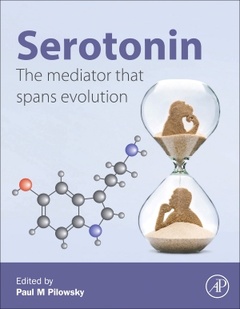Serotonin The Mediator that Spans Evolution Molecular Mediators in Health and Disease: How Cells Communicate Series
Coordonnateur : Pilowsky Paul M.

Serotonin: The Mediator That Spans Evolution provides a comprehensive review of the widespread roles for serotonin in respiratory, cardiovascular and thermoregulatory control, and for growth and development in early life. This important resource highlights serotonin?s role in normal (unstressed) conditions, and in response to a variety of physiological stressors. It focuses on new animal models, comparing and contrasting data from mice and rats. In addition, the book compares and contrasts the physiological effects of brain and blood serotonin systems and includes new data suggesting that the influence of serotonin is in part through the regulation of gene expression.
Finally, it discusses the role of serotonin system dysfunction in a variety of pathophysiological conditions, including sleep apnea, obesity and hypertension, and presents compelling evidence that this dysfunction is involved in Sudden Infant Death Syndrome (SIDS).
BIOPHYSICS OF SEROTONIN 1. Biophysics of Serotonin and the Serotonin1A Receptor: Fluorescence and Dynamics 2. Serotonin in plants: origin, function, and implications
ANATOMY 3. The anatomy of the serotonin system in different model systems: rat fish, flies and C. Elegans 4. Serotonin in the endocrine pancreas 5. Serotonin and platelets 6. Anatomy of the Serotonin Transporter
PHYSIOLOGY IN THE PERIPHERY 7. Cellular regulation of peripheral serotonin 8. Role of 5-HT in the control of gut motility 9. Phenotype of animals deficient in peripheral serotonin 10. Serotonin and immune system 11. Serotonin and Adipocyte Function 12. Serotonin and cardiovascular diseases 13. Involvement of 5-HT in afferent modulation of brainstem circuits regulating cardiovascular homeostasis 14. Regulation of nociceptor signalling by serotonin
PHYSIOLOGY IN THE BRAIN 15. Brain serotonin and energy homeostasis 16. Serotonin in central cardiovascular control 17. Serotonin receptors and cardiovascular control 18. Serotonin receptors as the therapeutic target for central nervous system disorders 19. Serotonin and the reconfiguration of the eupneic respiratory pattern 20. Life without brain serotonin: phenotype of animals deficient in central serotonin synthesis
Basic and clinical researchers of systems physiology as well as clinicians.
He was responsible for the initial development of a new medical school at Macquarie University in Sydney. His service to Neuroscience was recognised by the award of the Australian Neuroscience Medal. He mentored 26 graduate students to on-time completion, and mentored 24 post-Doctoral Fellows, many of whom now have their own established careers.
In imagining this book, it was felt that a departure from the usual highly focussed text would be of interest. Hence, a multi-Author volume has been created that reveals the multiple facets of a neurotransmitter with very broad actions.
- Includes the latest information on new animal models of serotonin system dysfunction
- Explores the wide scope of serotonin’s influence on multiple organ and physiological systems
- Highlights the autonomous functioning of the brain and body serotonin systems
- Provides compelling evidence of serotonin dysfunction in SIDS, a leading cause of death in infancy
Date de parution : 09-2018
Ouvrage de 420 p.
19x23.3 cm
Thèmes de Serotonin :
Mots-clés :
a-cells insulin secretion; ß-cells; 5-HT receptors; 5-HT transporter; 5-HT; 5-HT1A; 5-HT2A; 5-HT3 receptors; 5-HT7 receptors; 5-HTT; 8-OH-DPAT; Adipocytes; Adipose tissue; Aggression; Allodynia; Anatomy; Anxiety; Astrocytes; Baroreceptors; Behavior; Blood pressure; Body weight; Bone marrow; Brain; Brainstem; Breathing; Cadiac remodeling; Cardiopulmonary reflex; Cardiovascular; Chemoreceptors; Cognitive impairment; Colonic migrating motor complexes; Cytokines; Depression; Development; Dorsal vagal nucleus; Enterochromaffin cells; Enterochromaffin; Evolution; FCS; Food intake; FRAP; Free fatty acids; G protein–coupled receptors; GABA; Gastrointestinal motility; Gastrointestinal; GPCR; Granisetron; Growth retardation; Gut; Heart rate; Hemostasis; High-precision liquid chromatography; Histochemistry; Hyperalgesia; Indoleamine; Inflammation; Insulin signaling; Islets of Langerhans; Knockout mouse; Lateral dynamics; Mechanotransducers; Medulla; Melatonin; Metabolism; Microglia



